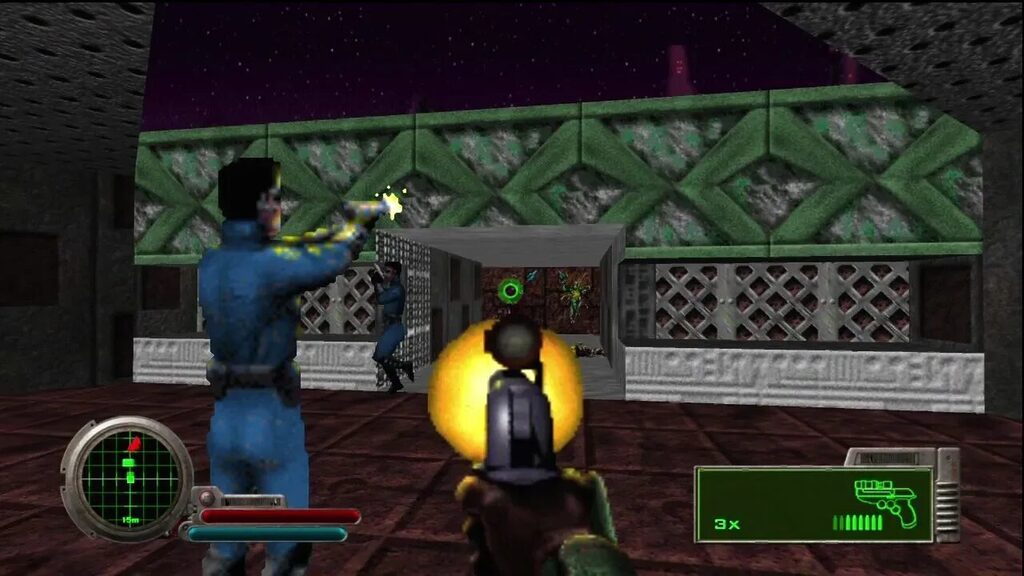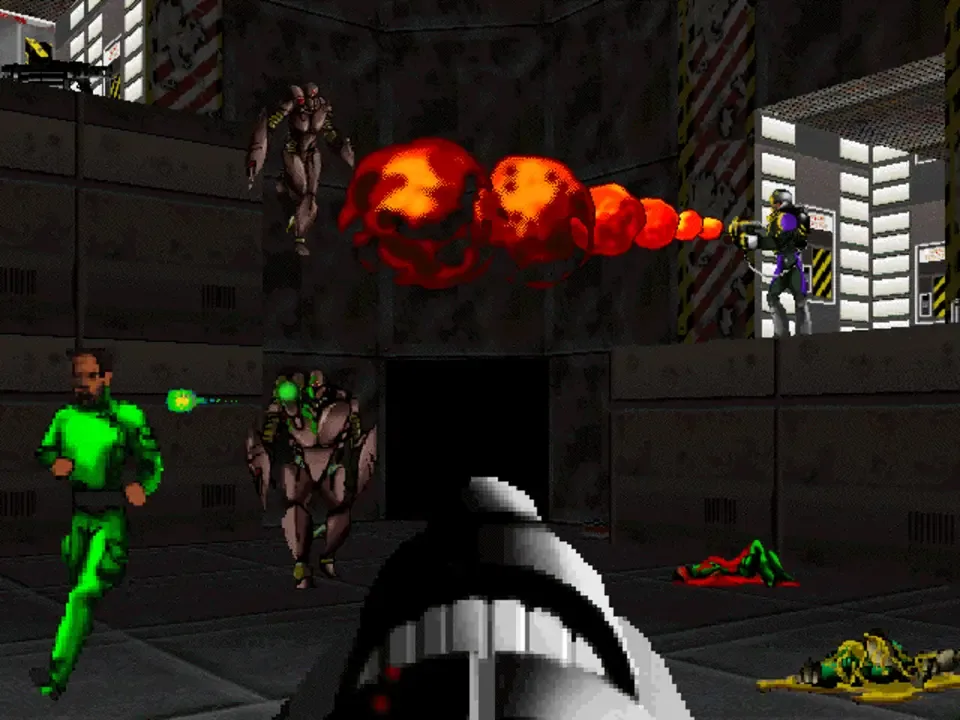The past is often thought of linearly following a specific timeline of events that arrive with us to the present day. It’s an accepted reality that games like DOOM helped usher in the concept of first-person gaming even if DOOM wasn’t the very first-person shooter or even anywhere close to the first. The genre originated in the 1970s with games like Maze War and Spasim while DOOM was released two decades later in the 1990s.
The earliest iterations of FPS games were all collectively arcade shooters, including DOOM. One game studio diverged the path of history with “Pathways into Darkness” and the non-sequel “Marathon” series. These introduced us to the concept of a FPS game with both story, puzzles, platforming and adventure elements.
Pathways into Darkness and Marathon are directly responsible in so many ways for the game design of every single FPS game that was created from that point forward. While DOOM gets a ton of credit for popularizing the genre, it doesn’t deserve the credit for giving the genre the depth that Pathways and Marathon created.
That’s both for the good and the bad. Innovation brings iteration and a lack of innovation can quickly stagnate entire mechanics (or games) while innovation itself doesn’t guarantee success.

Where to Play Marathon
Classic Marathon on Steam (steampowered.com)
If you’re curious of the timeline, we’ve got a summary of that as well: Bungie Multiverse Mythos and Timeline Overview.
Historical Records of Marathon
There is no iteration without innovation first and in the early 1990s innovation was huge as the transition from 2D into realistic 3D maps was occurring. We often associate Doom (1993) as the first major FPS game, but it was actually an iterative design based on Wolfenstein 3D (1992), Catacomb 3-D (1991) and Hovertank 3D (1991). These precursor games defined what would shape up to be one of the most memorable and first FPS games in the market. Doom drastically expanded market share for FPS games and provided the desire that continued to drive the genre.
The games above are all arcade shooters, putting you into maps and having you move through until you reach the end. Bungie, having played Wolfenstein 3D, attempted to port their Minotaur series into 3D but settled instead of making a new game: Pathways into Darkness. Pathways was a 3D game that included story elements, an inventory, story items, multiple endings and otherworldly elements like the ability to talk to the deceased.
Following the success of Pathways, Bungie released the non-sequel Marathon which again started as a sequel of Pathways but morphed into its own game: a sci-fi FPS with adventure elements, platforming and a story with a considerable amount of story text. Marathon was more Half-Life than it was Doom, considerably before Half-Life would release.
Marathon and Marathon II would become and are the blueprint for almost every FPS game since then. Mission objectives, free look, traps, spooky low lightening atmosphere used against you and puzzles using terminals. Multiplayer, while not a first, was the first major FPS game with highly anticipated multiplayer support.
Redefining the Genre
Marathon was the go forward basis for almost every single FPS game since then. You load into a map, with an objective (and even optional objectives). There’s weapons and health pickups strategically placed about and you’ll need to get various “quests” (go and do something) to advance through the game which can range from fetch quests, elimination quests or reaching a specific point (almost like Helldivers 2 missions!).
This formula was the core of what made Halo the success it was, a highly refined version of Marathon with cinematic story but the same core elements: you have a mission to complete on each map, a generally linear but can sometimes be a bit labyrinth style where you can get lost and turned around easily. The spooky dark hallways and playing with the atmosphere come back.

This is all based purely on the dedication of Alex Seropian and Jason Jones’ passion to get their games to the market and develop something new in an age of innovation. Much like the originators of innovation, what they created, the blueprint that they made, became the law for decades after.
Likewise, Ken Silverman who made the “BUILD Engine” for a game called Ken’s Labyrinth would become the basis for Duke Nukem 3D, which iterated on most of the above and innovated with destructible environments within a 2.5D engine. Innovation and iteration play along with each other to continue to grow the genre forward, but also can root specific designs as “de facto” requirements.
Consequence of Design
Iterating on the FPS formula and then innovating really satisfying mechanics results in a future where most games follow the blueprint established. System Shock went more for the extreme of making the story and gameplay more complex. While successful, most of the iteration focused on making the games more accessible, with better graphics and injecting more of a cinematic element to the story instead of the info dump terminals.
You can find the blueprint from Marathon below:
- You have a vague reason to go do something.
- The something you need to do is for the greater good of everyone.
- There’s powerups and health packs strategically placed.
- You’ll likely need to get some kind of keycard or object to progress or information from someone.
- Melee is higher risk in exchange for not worrying so much about ammo, whereas ammo itself is everything from a reloading mechanic to an ammo conservation mechanic. The maps in Marathon had A LOT of variation!
Take all of the above and iterate on it and you have Goldeneye 64, you have Halo, you have Fable, you have The Witcher III, etc. Even third person games mostly follow the same formulas and the same mechanics, although they probably try to borrow far more from Mario 64 (1996) unless you’re talking something like Mass Effect which again is just the Marathon base formula.
These decisions, while they could organically form from the needs of the market of the time, do also become the early blueprints that everything then follows. Their legacy sticks with us far beyond the timeframe where Marathon was known as a Mac exclusive and those decisions are locked into our past, defining our future.
Early Decisions Drive Design
Had Bungie developed something different, the entire genre itself could have been thematically different (the sci-fi elements from Marathon continued through many of the games, up to and including Half-Life). Instead, they did make Marathon and we have since both gained the pleasure of the game’s unique design but also the shackles of how it was designed and the iterative design of games.
Game designers / developers are keenly capable of taking the previous iterations of a formula and reskin it with their flourish. Much of the entire genre of most games go back to some core game, like SimCity or something like Alpha Centauri and just iterate on how it was built forever more. It’s not bad, but it has consequences which can be good or bad. We can be stuck for long periods of time with a specific design going on endlessly. A specific element that makes a game a “game changer” can quickly become a new genre of itself.
Everything that we play is built on the past and the past defines what we’re building in the future. It’s important to consider how these past elements play with the future.
BioShock
BioShock takes the blueprint that Marathon and all of its predecessors and wrapped it together and introduced rich cinematic storytelling and ethical dilemmas that were innovative. Taking the same and going in new directions created a game that is still memorable years and years after its release. There’s a large time gap between 1993 and 2007 but the same formula from Marathon exists in BioShock. It’s still there, just built upon through iteration and new innovation.
Legacy and Evolution, Innovation vs. Iteration
Looking through the evolution of first-person shooters, it’s evident that while games like “DOOM” were instrumental in popularizing the genre, it was the pioneering efforts of titles like Pathways of Darkness and Marathon that enriched the genre with its unique depth and complexity. These narrative-driven, intricate puzzle solving and primitive platforming would become the staple formula for FPS games all the way to the current modern era and likely beyond.
This progression isn’t without its challenges. We’re often just doing the same thing over and over again, which causes many games to fail simply because what already exists does it just as good or better, meaning the finite number of players focus more on what they know then to try something new that’s the same.
We’re always at a crossroads with the future and it’s interesting how small decisions, especially in hyper active periods of time like the early 90s can result in so many butterfly effects as iterative design rides what worked and drives a better version of it into the future.
I challenge you to consider how many games you played that were just iterative copies of another popular game that came before it and continue this train of thought until you can get to the earlier version. Think about what elements were dropped, what was carried forward and how this all plays together.
It can help you respect not only the past but understand why we’re often locked into these few select styles of play and why unique gameplay is often boosted to the top of the sale’s chart, even if it’s based on something that exists, if it’s different enough – the players will come play.
Consider if some function you like was an iteration or an innovation. The more innovations a game has, the more unique it is; but innovation itself isn’t success – it’s trial and error. Iteration itself is taking what works, but has been consumed and trying to enhance it. What games do you feel broke the mold? Let us know in the comments below.






